The hellebore flower is a welcome sight for winter-weary gardeners once they begin to bloom (sometimes even while the ground is still covered with snow). Often one of the first plants to emerge, hellebores have long-lasting, fragrant flowers that signal spring is on the way! Here’s what you need to know about these early spring beauties.
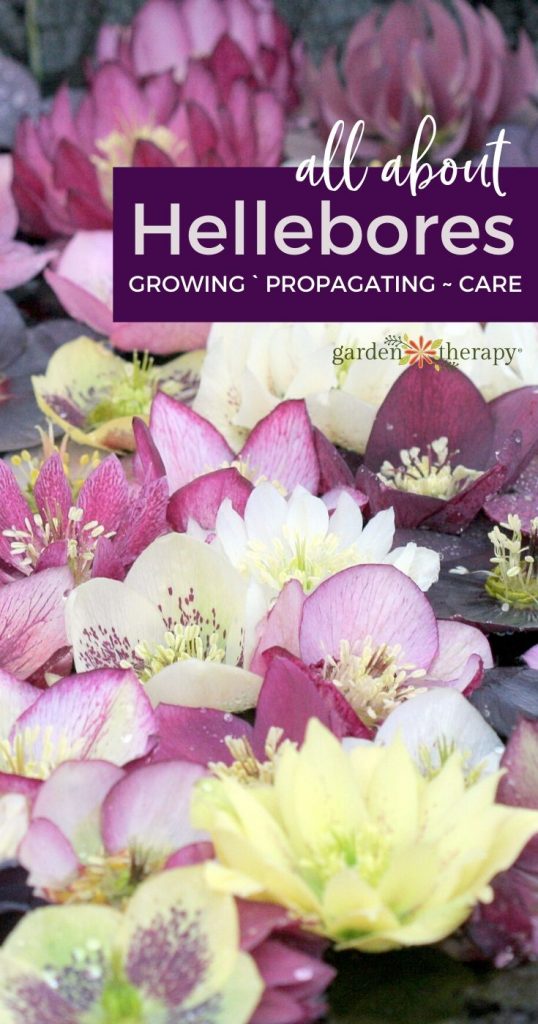
Often called the Lenten rose, Hellebores create excitement in gardeners which pales in comparison to other perennials (I can just hear gardeners everywhere saying “hooray for hellebores!”). These beautiful flowers come in gorgeous rich colours, festive textures, and showy patterns.
Even so, you could miss them if you don’t stop to look. Their delicate blooms are shy, hanging their heads and hiding the most beautiful ruffles, freckles, and colours from the everyday passersby. Once you take the time to get to know them, you’ll be smitten too!
Winter blooming plants are prized by gardeners’ cool climates, as it’s always a joy to see those first blooms peeking out, even through snow covered garden beds. Practically an evergreen perennial, there are few plants that equal hellebore’s unique qualities. They have long-lasting blooms, require little maintenance, and can tolerate both snow and dry shade. Hooray for winter loving plants!
Varieties of the Hellebore Flower
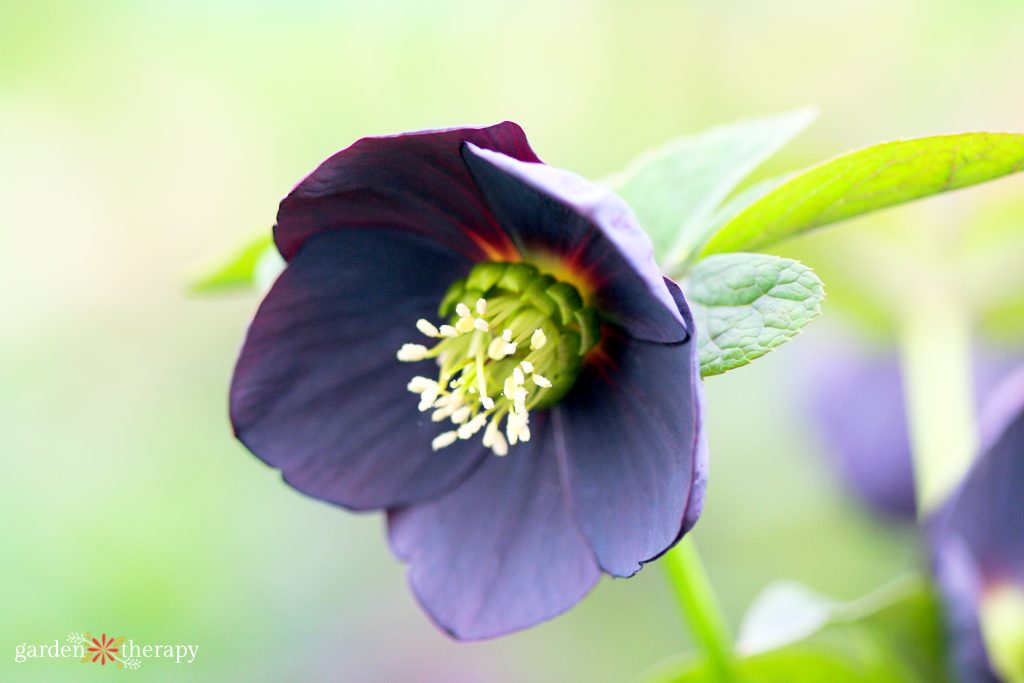
There are approximately twenty species of hellebore flowers and each have countless varieties available. Though they share many similarities, their differences in size, foliage texture, leaf colour, bloom time, and flower colour make them a dream flower for any gardener.
Hellebore flowers come in pretty much any colour you might want: white, green, pink, apricot, and purple, to name just a few. In a garden, you can intermingle numerous species and hybrids and enjoy a greater variety of colours and textures as well as longer bloom times. Here are 3 popular species you may have heard of:
Helleborus Orientalis
One of the first varieties to bloom, helleborus orientalis offers the greatest variety of colours and patterns with dark green, serrated leaves. Many hybrids stem from this variety and are the ones most often seen in home gardens.
Helleborus Foetidus
This species of hellebores has a rather interesting nickname of “the stinking bear foot” or “bear paw hellebore”, and will bloom beautiful flowers with a pastel green hue. You may have guessed it from the nickname, but it also gives off an unusual fragrance that many people seem to dislike. If you plant this one, be aware that this is one of the few hellebores that enjoy more sun!
Helleborus Niger
Known as the Christmas Rose, this species features 3-inch pure white blooms from late winter to early spring, on purple-spotted 1-foot-tall stems. This plant has a distinct leathery texture on its fingered evergreen leaves.
Related: the most Popular Hellebore Selections and 5 Stunning Hellebore Varieties You MUST See!
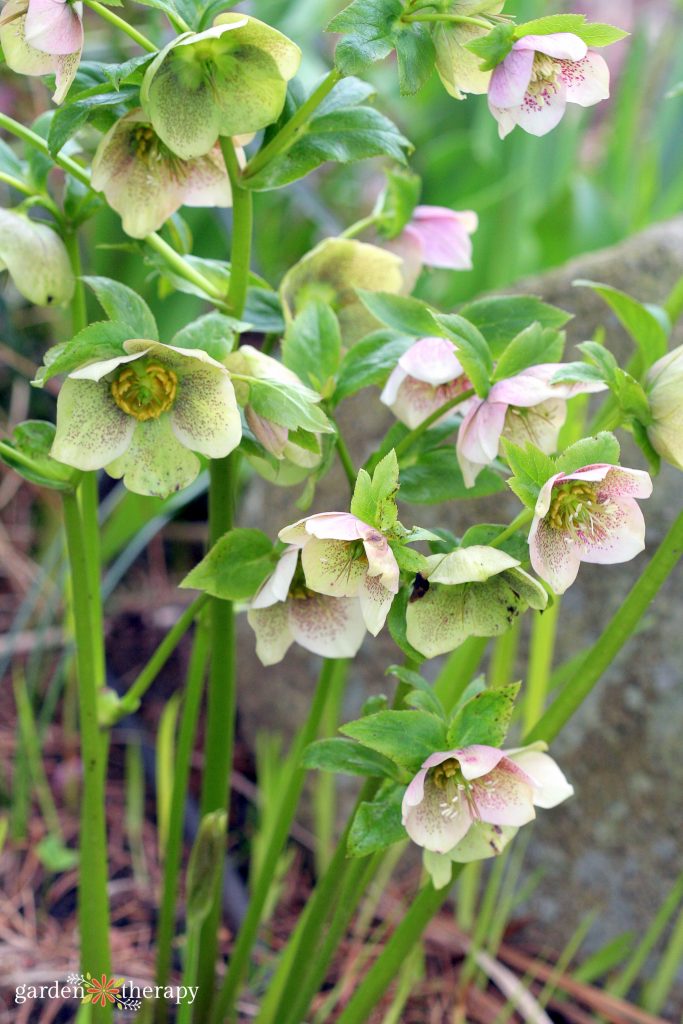
Helleborus interspecific hybrids offer endless varieties and choices in colour and form that aren’t available in other species. More arrive on the market every year and feature all sorts of colour and variegation on both foliage and flowers.
Currently, most new hellebore flower varieties contain either semi-double, double, and anemone flower forms, deep colours, vivid patterns or some combination of these elements. Additional popular features include spot resistance and patterns of silver, wine, and gold.
Your best bet for choosing a variety based on appearance is to see it in bloom firsthand to know exactly what it will look like.
How to Grow and Care for Hellebores
How do you care for hellebores? They are surprisingly simple to grow, preferring to be left to (mostly) fend for themselves. Here’s everything you need to know about caring for your Lenten rose all year long.
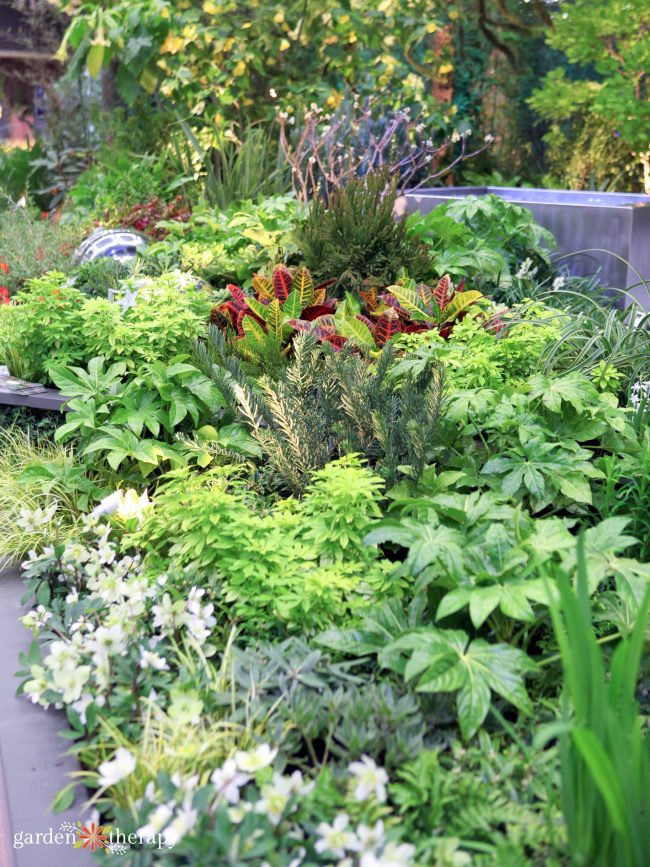
Soil and Location
Site selection is critical for gardening success. Where is the best place to plant hellebores? Here is everything you need to know in order to pick the best spot in your garden for these shady blooms.
- Hellebores enjoy slightly neutral to acidic soils.
- They need to keep their roots on the drier side to prevent rot, so don’t plant in a spot that will get too much water.
- They are very sensitive to poor drainage, so if you do get lots of rain as we do in the Pacific Northwest be sure your soil is well-amended with coarse organic matter to improve the structure and balance of soil moisture levels.
- Combine hellebores with ferns, hosta, or heuchera for a beautiful shade perennial garden. Plant them as a groundcover to naturalize in open woodlands. Or use them as accents along pathways or shrub borders and even in containers.
- Hellebores can withstand temperature 18°C and below, making them a great plant for colder climates. They will work in most zones until zone 4. At zone 3, you can still grow hellebores but will likely need some additional protection.
Light
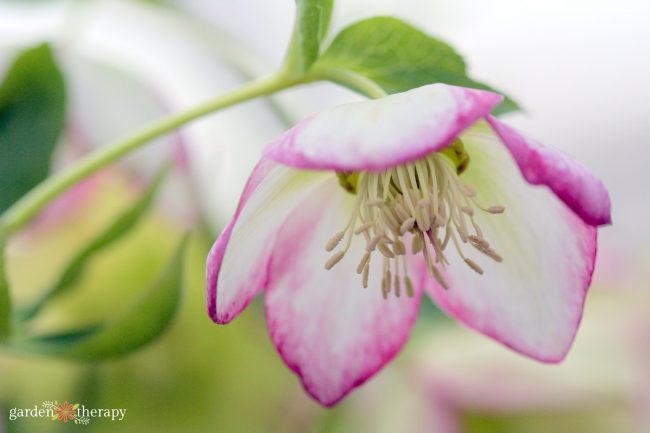
The hellebore flower prefers shade, especially in the afternoon, or dappled sunlight such as an open forest canopy provides.
However, dense shade can reduce flower production. A welcome spot to place hellebores is under a tree. In the spring, they will get just enough light and in the summer as the foliage grows, they will get partial shade.
Watering Hellebores
- During the establishment phase, keep young plants evenly moist.
- After a year or so, hellebores become quite drought-tolerant, only requiring supplemental irrigation during the driest spells.
- They use quite a bit of water during their growing season (spring and fall). However, you can water them less when they go dormant during the heat of summer.
Planting & Care
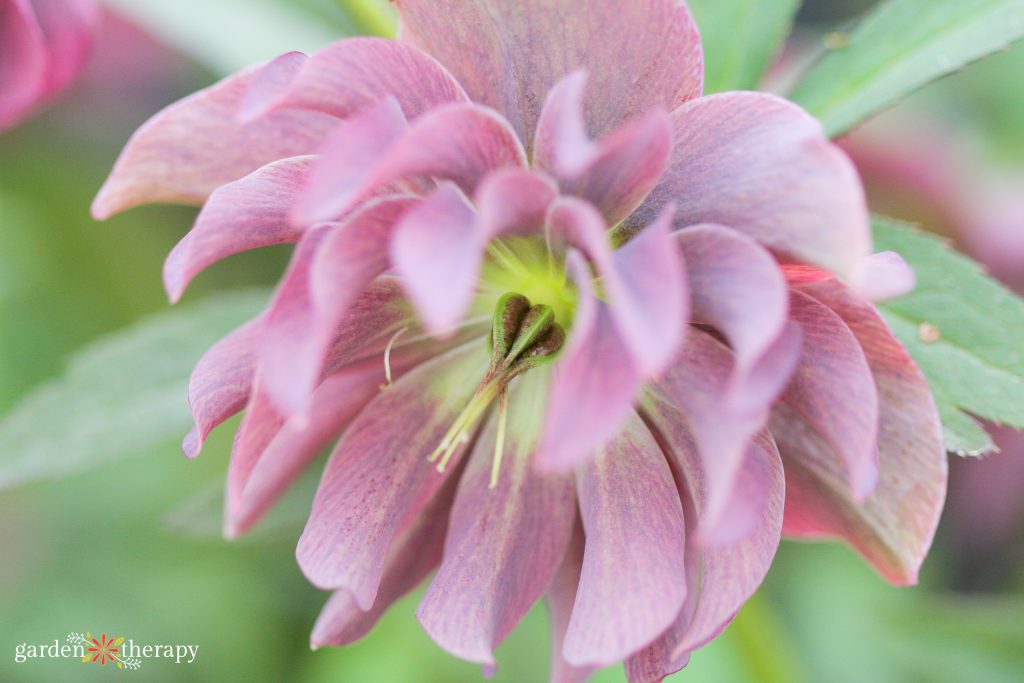
The Lenten rose is a relatively low maintenance plant. You will do most of your work the day you plant it!
- For seedlings, plant them in the fall. Hellebore seeds need a 60-day moist chilling period in order to sprout. Planting seeds in fall allows this to happen naturally in areas with cold winters.
- Plant the seeds deep enough so that the soil just barely covers the crown. Similar to peonies, if you plant hellebores too deep it can stifle your flower production.
- Flowers will appear on plants grown from seed in three to four years.
- Divide any overgrown clumps during a dormant period – either in the spring, after flowering, or in late autumn.
- Once new growth appears in the spring, cut back any old, damaged growth. Do this before the flowers develop too much and you risk accidentally damaging them. New leaves will grow and fill in any empty spaces quickly.
- In the summer, don’t deadhead your hellebores. The flower heads are quite ornamental and will last through most of the summer if left as is. You may get some seedlings, but you can weed them out as you see fit.
Fertilization for Hellebores
Supplemental fertilizer is not necessary for blooming as long as your soil is amended. Boost the growth and blooms of hellebores by applying manure or compose annually.
This is best done in the fall while the ground is still workable. As your hellebores wake up out of dormancy after the summer, they will have all the nutrients they need.
Pests & Diseases
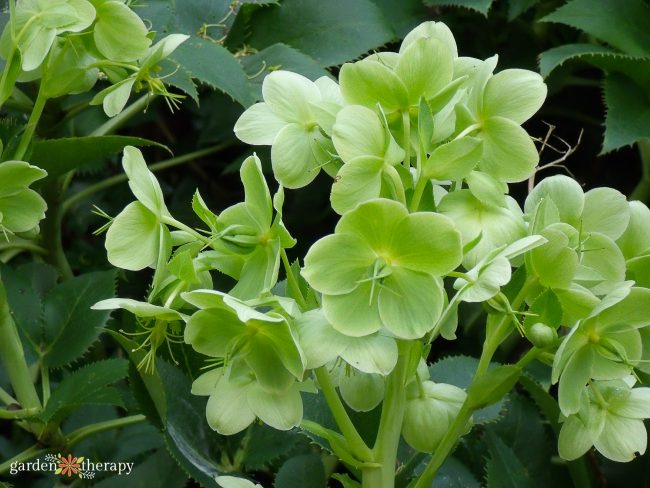
These frost-resistant, shade-loving evergreens are for the most part unbothered by things that can often harm plants, including pests and diseases. Despite this, there are a few things to keep an eye out for.
- Aphids like the new growth, so it’s best to invite many beneficial insects to your garden. Ladybugs will be your friend!
- If you notice spots on the leaves, they are likely a type of fungus. To treat the fungus, remove the spotted leaves and throw them away. Don’t let the fungus breed in your garden by allowing it to linger on the leaves and get into the soil. Chemical control is often unnecessary if you are on top of removing the damaged leaves.
- Hellebores are also rather deer resistant. If you find that deer like munching on all your flowers, try planting hellebore for blooms that are more likely to last.
Propagating Your Hellebore Plants
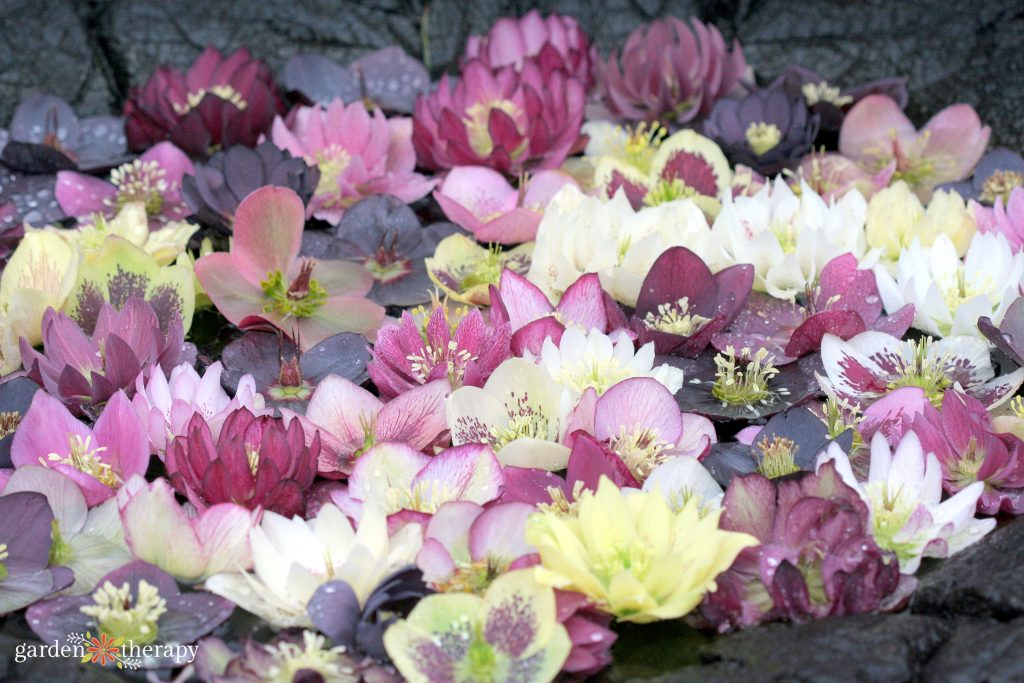
If you want to propagate your own hellebores, the easiest way is to divide the plants when they are dormant. Hellbores do their growing during the fall, winter, and spring. Once the plant has finished flowering, it is safe to divide it.
You can start them from seed, but don’t be surprised if your seedlings are not the same as their parent type. If you really want an exact duplicate, you’ll need to try dividing plants.
Dividing hellebores is no different than the process for dividing many other perennials. It is best done when the plant has finished blooming and is becoming crowded.
An unparalleled early spring flower, enjoy hellebore plants to their fullest with these proven tips for care. Have fun with these beautiful blooms!
More Gorgeous Garden Guides:
- The Essential Guide to Hydrangeas
- Echinacea Guide: Planting, Pruning and Caring for Coneflowers
- Herbal Guide to Hops: Growing, Harvesting, and Using Hops
- The Essential Guide to Growing Lavender
- 10 Fragrant Flowers For a Heavenly Smelling Garden
- The Essential Guide to Growing Hostas, the Shade Garden Beauty




In the first picture the Hellebores look like very colorful Nymphaeas
Don’t they? I love to display hellebore blooms in a shallow dish of water like this. I took the photo during the opening weekend of one of my favourite garden centers where they had all of these varieties for sale!
Thanks for shared this post very nice post i really like your post…..images are so beauty..
Hello Stephanie
I have collected 14 different kinds almost during that time period of 14 years .. depending on what was available. I am curious about what the best type of fertilizer would be for them. I think they are in need since some of them are not flowering as consistently as other older ones.
This was a great post and most of us are dreaming of hellebore flowers soon to come !
Thanks !
Hi Joy, you are like me! Collecting hellebores each year :) In terms of fertilizer, my personal garden philosophy is to look at the soil first. I don’t use any additional fertilizers in my garden, I just build strong, healthy soil. See more about that in this guest article from a soil scientist: https://gardentherapy.ca/soil-food/
Dear Stephanie, you are not only a successful artistic gardener but also you are the professional photographer! Very good article.
My Hellebores look really distressed from our winter here in Georgia. As you suggested, I will cut back all the damaged leaves and hope for more soon. I have had them in pots and placed with Hostas and ferns for a few years now. They have really struggled. Do you fertilize?
I don’t fertilize, but instead, I amend the soil yearly with compost and other green amendments: https://gardentherapy.ca/soil-food/